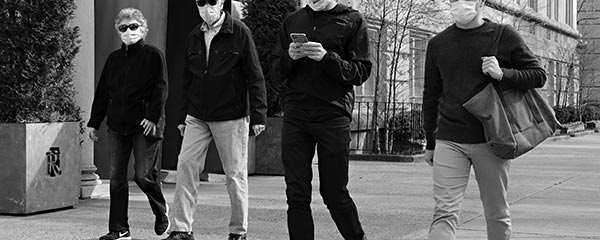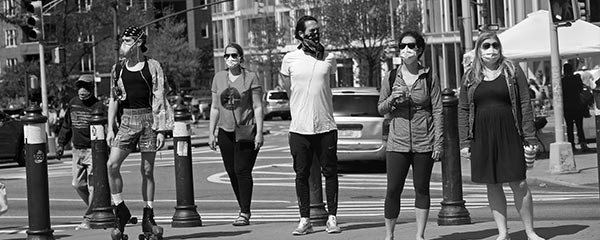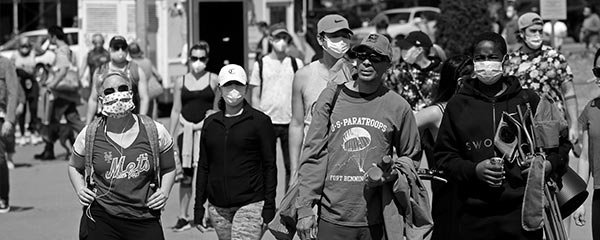Story Highlights
- 58% completely or mostly isolating self, down from peak of 75%
- Decline among those in states with and without stay-at-home orders
- More report going to work, grocery stores and other's homes
WASHINGTON, D.C. -- Fifty-eight percent of U.S. adults report they are completely (17%) or mostly (41%) isolating themselves, continuing a decline from a high of 75% the week of March 30-April 5, and back to the level seen before most states had implemented stay-at-home orders to stop the spread of the coronavirus.
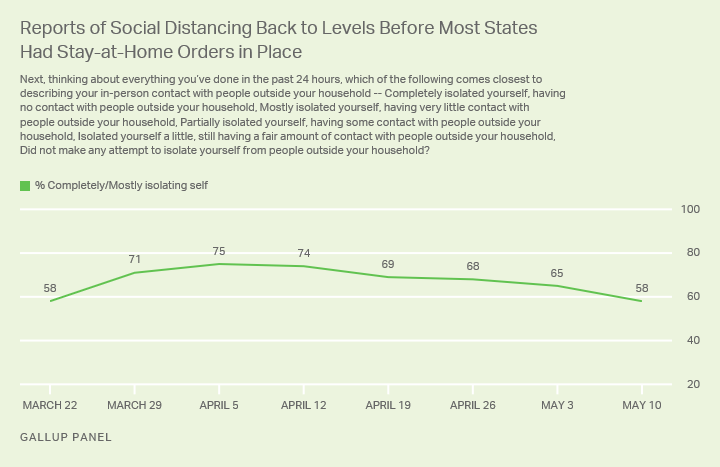
These results, based on May 4-10 interviewing, come as many states' stay-at-home orders expired as an increasing number of states are taking steps to reopen their economies. Many state restrictions expired before last week's interviewing began, but some were lifted during the week.
A month ago, when all but a few states had stay-at-home orders in place and the number of new coronavirus infections was climbing, three-quarters of Americans said they were completely or mostly isolating themselves. Since then, the percentage completely or mostly isolating has decreased at least marginally each week, including a 10 percentage-point-total decline over the past two weeks.
Downward Trend Seen in States With and Without Stay-at-Home Orders
Gallup finds declines in social distancing among residents of states that have scaled back social distancing orders, but also among residents of states that haven't loosened restrictions.
On May 4, at the start of last week's interviewing, 21 states had no stay-at-home order in place for their residents, either because theirs had expired or they never had one. Fifty-one percent of adults living in these states said they were completely or mostly isolating themselves. That compares with 64% of adults in those same states two weeks earlier when most of those states still had stay-at-home orders.
The percentage of adults completely or mostly isolating themselves also fell among residents of states that have maintained stay-at-home orders over this two-week period. The rate fell seven points from 71% in the April 20-26 reading to 64% May 4-10. Thus, factors other than one's own state's guidelines are evidently behind individuals' decisions to get back into society.
| April 20-26 | May 4-10 | Change | |||||||||||||||||||||||||||||||||||||||||||||||||||||||||||||||||||||||||||||||||||||||||||||||||
|---|---|---|---|---|---|---|---|---|---|---|---|---|---|---|---|---|---|---|---|---|---|---|---|---|---|---|---|---|---|---|---|---|---|---|---|---|---|---|---|---|---|---|---|---|---|---|---|---|---|---|---|---|---|---|---|---|---|---|---|---|---|---|---|---|---|---|---|---|---|---|---|---|---|---|---|---|---|---|---|---|---|---|---|---|---|---|---|---|---|---|---|---|---|---|---|---|---|---|---|
| % | % | pct. pts. | |||||||||||||||||||||||||||||||||||||||||||||||||||||||||||||||||||||||||||||||||||||||||||||||||
| All U.S. adults | 68 | 58 | -10 | ||||||||||||||||||||||||||||||||||||||||||||||||||||||||||||||||||||||||||||||||||||||||||||||||
| Residents of states with stay-at-home order in effect as of May 4 |
71 | 64 | -7 | ||||||||||||||||||||||||||||||||||||||||||||||||||||||||||||||||||||||||||||||||||||||||||||||||
| Residents of states with no stay-at-home order in effect as of May 4 |
64 | 51 | -13 | ||||||||||||||||||||||||||||||||||||||||||||||||||||||||||||||||||||||||||||||||||||||||||||||||
| Gallup Panel | |||||||||||||||||||||||||||||||||||||||||||||||||||||||||||||||||||||||||||||||||||||||||||||||||||
The analysis also reveals a persistent gap in self-isolation between those who are currently living under, and not living under, stay-at-home restrictions, which preceded the lifting of such restrictions in many of the latter states. Also, it is still the case that a slim majority of residents in states without restrictions on citizen movement are completely or mostly isolating themselves from people outside their homes.
Regardless of state-level restrictions, the poll finds women (67%) continue to be more likely than men (49%) to say they are mostly isolating themselves. Both gender groups have become less likely to practice social distancing in the past two weeks, but the decline has been larger among men (14 points) than women (7 points).
Democrats (72%), independents (57%) and Republicans (45%) also continue to differ significantly in their self-reported social distancing, with similar declines among the party subgroups since late April.
More People Report Going to Public Places
Consistent with of the finding that fewer Americans are engaging in strict social distancing, increasing percentages report they have gone to public places in the past 24 hours, including their workplace (now 30%), a grocery store (49%) and someone else's house (19%). Notably, there has been no change in reports of going to restaurants (13%) in the past three weeks.
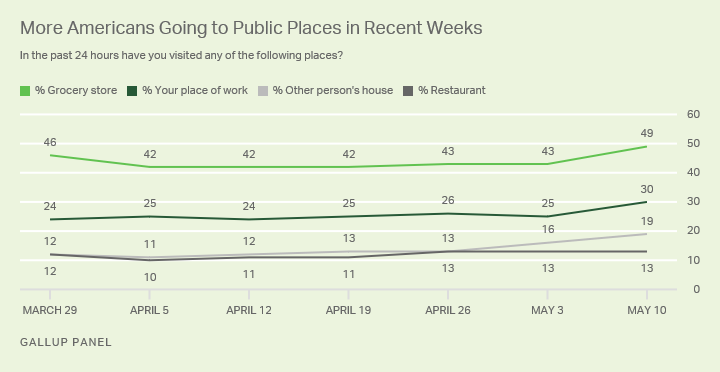
Americans in states with and without stay-at-home orders have been more likely to go to public places in recent weeks. The biggest shift has been a 10-point increase in the percentage visiting a grocery store among those not under stay-at-home restrictions.
| April 20-26 | May 4-10 | Change | ||||||||||||||||||||||||||||||||||||||||||||||||||||||||||||||||||||||||||||||||||||||||||||||||||
|---|---|---|---|---|---|---|---|---|---|---|---|---|---|---|---|---|---|---|---|---|---|---|---|---|---|---|---|---|---|---|---|---|---|---|---|---|---|---|---|---|---|---|---|---|---|---|---|---|---|---|---|---|---|---|---|---|---|---|---|---|---|---|---|---|---|---|---|---|---|---|---|---|---|---|---|---|---|---|---|---|---|---|---|---|---|---|---|---|---|---|---|---|---|---|---|---|---|---|---|---|
| % | % | pct. pts. | ||||||||||||||||||||||||||||||||||||||||||||||||||||||||||||||||||||||||||||||||||||||||||||||||||
| A grocery store | ||||||||||||||||||||||||||||||||||||||||||||||||||||||||||||||||||||||||||||||||||||||||||||||||||||
| Residents of states with stay-at-home order in effect as of May 4 |
42 | 46 | +4 | |||||||||||||||||||||||||||||||||||||||||||||||||||||||||||||||||||||||||||||||||||||||||||||||||
| Residents of states with no stay-at-home order in effect as of May 4 |
45 | 55 | +10 | |||||||||||||||||||||||||||||||||||||||||||||||||||||||||||||||||||||||||||||||||||||||||||||||||
| Your place of work | ||||||||||||||||||||||||||||||||||||||||||||||||||||||||||||||||||||||||||||||||||||||||||||||||||||
| Residents of states with stay-at-home order in effect as of May 4 |
23 | 26 | +3 | |||||||||||||||||||||||||||||||||||||||||||||||||||||||||||||||||||||||||||||||||||||||||||||||||
| Residents of states with no stay-at-home order in effect as of May 4 |
32 | 36 | +4 | |||||||||||||||||||||||||||||||||||||||||||||||||||||||||||||||||||||||||||||||||||||||||||||||||
| Someone else's home or apartment | ||||||||||||||||||||||||||||||||||||||||||||||||||||||||||||||||||||||||||||||||||||||||||||||||||||
| Residents of states with stay-at-home order in effect as of May 4 |
13 | 20 | +7 | |||||||||||||||||||||||||||||||||||||||||||||||||||||||||||||||||||||||||||||||||||||||||||||||||
| Residents of states with no stay-at-home order in effect as of May 4 |
14 | 19 | +5 | |||||||||||||||||||||||||||||||||||||||||||||||||||||||||||||||||||||||||||||||||||||||||||||||||
| Gallup Panel | ||||||||||||||||||||||||||||||||||||||||||||||||||||||||||||||||||||||||||||||||||||||||||||||||||||
Public Still Values Staying Home
Even as an increasing percentage of Americans are no longer required to shelter in place, 73% of U.S. adults say the better advice for healthy people is to stay-at-home as much as possible, rather than leading their normal lives as much as possible (27%). The percentage who think staying home is the better option has declined modestly since late April, and even more since late March, but it remains the dominant view.
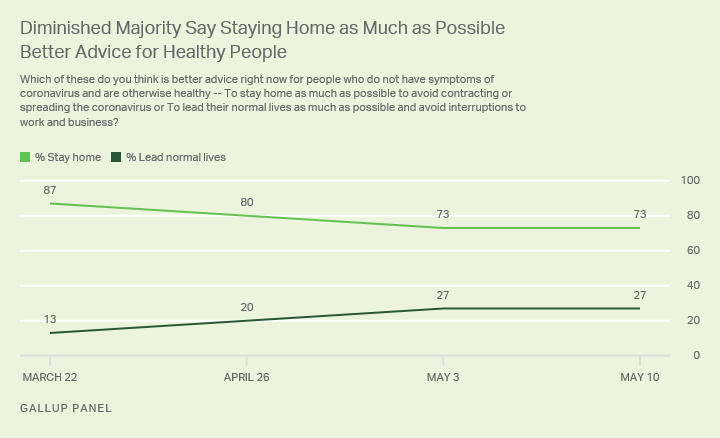
Sixty-eight percent of those in states without stay-at-home orders believe staying home as much as possible is the better option, as do 77% of those who are currently living under such orders.
People living in states with and without stay-at-home directives are similar in their rankings of which factors are most important for them to be willing to return to their normal activities. Mandatory quarantines of those with COVID-19 symptoms, a significant reduction in the number of new coronavirus infections or deaths, and improved medical therapies for treating COVID-19 are the top factors for both groups. The biggest difference between the two groups -- nine percentage points -- concerns the importance they ascribe to widespread testing to identify and monitor coronavirus infections.
| State has stay-at-home order | State does not have stay-at-home order | ||||||||||||||||||||||||||||||||||||||||||||||||||||||||||||||||||||||||||||||||||||||||||||||||||
|---|---|---|---|---|---|---|---|---|---|---|---|---|---|---|---|---|---|---|---|---|---|---|---|---|---|---|---|---|---|---|---|---|---|---|---|---|---|---|---|---|---|---|---|---|---|---|---|---|---|---|---|---|---|---|---|---|---|---|---|---|---|---|---|---|---|---|---|---|---|---|---|---|---|---|---|---|---|---|---|---|---|---|---|---|---|---|---|---|---|---|---|---|---|---|---|---|---|---|---|
| % | % | ||||||||||||||||||||||||||||||||||||||||||||||||||||||||||||||||||||||||||||||||||||||||||||||||||
| Mandatory quarantine for anyone testing positive with COVID-19 | 82 | 80 | |||||||||||||||||||||||||||||||||||||||||||||||||||||||||||||||||||||||||||||||||||||||||||||||||
| Improved medical therapies to treat COVID-19 | 79 | 74 | |||||||||||||||||||||||||||||||||||||||||||||||||||||||||||||||||||||||||||||||||||||||||||||||||
| A significant reduction in the number of new cases or deaths | 75 | 77 | |||||||||||||||||||||||||||||||||||||||||||||||||||||||||||||||||||||||||||||||||||||||||||||||||
| The availability of a vaccine to prevent COVID-19 | 69 | 67 | |||||||||||||||||||||||||||||||||||||||||||||||||||||||||||||||||||||||||||||||||||||||||||||||||
| Assurances from medical authorities that local hospitals have capacity to accept patients | 66 | 63 | |||||||||||||||||||||||||||||||||||||||||||||||||||||||||||||||||||||||||||||||||||||||||||||||||
| Widespread testing to identify and monitor coronavirus infections | 63 | 54 | |||||||||||||||||||||||||||||||||||||||||||||||||||||||||||||||||||||||||||||||||||||||||||||||||
| Requirements that people maintain six-feet distance from each other | 54 | 47 | |||||||||||||||||||||||||||||||||||||||||||||||||||||||||||||||||||||||||||||||||||||||||||||||||
| Widespread "contact tracing" to monitor those exposed to the coronavirus | 52 | 45 | |||||||||||||||||||||||||||||||||||||||||||||||||||||||||||||||||||||||||||||||||||||||||||||||||
| People being required to wear facemasks in public | 51 | 43 | |||||||||||||||||||||||||||||||||||||||||||||||||||||||||||||||||||||||||||||||||||||||||||||||||
| Your state government lifting stay-at-home or social distancing restrictions | 37 | 35 | |||||||||||||||||||||||||||||||||||||||||||||||||||||||||||||||||||||||||||||||||||||||||||||||||
| Mandatory temperature checks before entering public buildings | 29 | 28 | |||||||||||||||||||||||||||||||||||||||||||||||||||||||||||||||||||||||||||||||||||||||||||||||||
| Figures are the percentage who say each factor is "very important" | |||||||||||||||||||||||||||||||||||||||||||||||||||||||||||||||||||||||||||||||||||||||||||||||||||
| Gallup Panel | |||||||||||||||||||||||||||||||||||||||||||||||||||||||||||||||||||||||||||||||||||||||||||||||||||
Barely more than one in three Americans say their state lifting or easing stay-at-home or social distancing restrictions is very important for them in deciding to return to their normal activities, with essentially no difference between those living or not living under such restrictions.
Implications
Americans have become less likely to stay away from others, and their level of social isolation now is similar to what it was before most states mandated that their citizens shelter in place to prevent the spread of the coronavirus. However, the majority of Americans are still isolating themselves regardless of stay-at-home orders in their states. While the level of social distancing may continue to decline in the coming weeks, the data suggest it will take more than lifting stay-at-home restrictions to encourage people to lead their normal lives again.
The coming weeks will be telling, as health officials track the trajectory of COVID-19 cases in places that are lifting restrictions on citizens' movement and travel. Should the number of cases stay flat or decline, it may encourage more people to leave their homes. However, an increase may lead to another, perhaps more prolonged, period of social distancing.
Learn more about how the Gallup Panel works.

